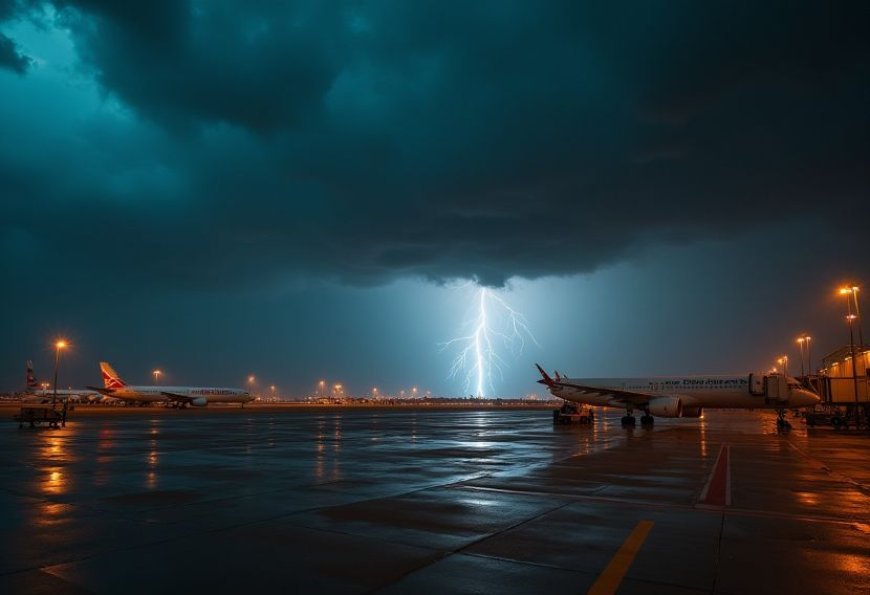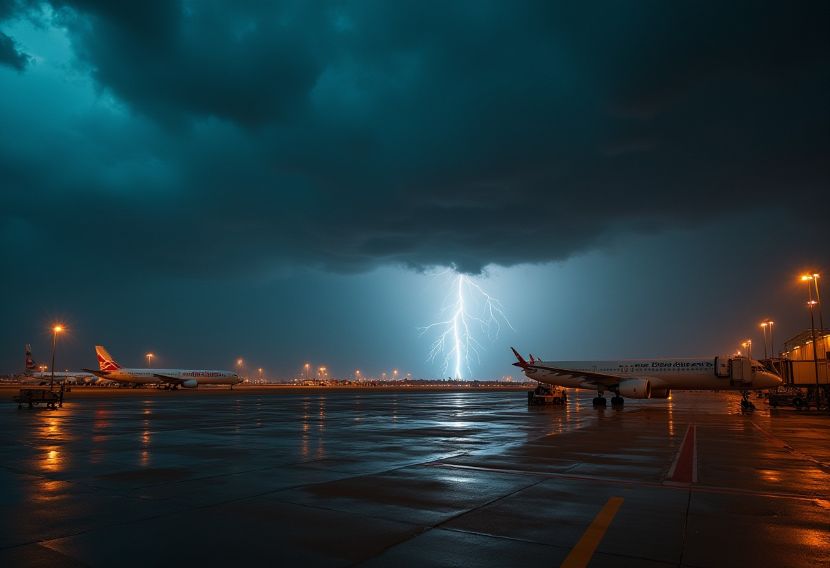Severe Thunderstorms Ground Flights at Denver International Airport, Causing Extensive Delays: Here’s What You Need To Know


On Saturday, August 3, 2025, Denver International Airport (DIA) faced significant disruptions as severe thunderstorms led to a ground stop, halting all flight operations for over an hour. The Federal Aviation Administration (FAA) initiated the ground stop at 2:40 p.m. due to the hazardous weather conditions. The disruption affected hundreds of flights, including major carriers like Southwest Airlines, United Airlines, and SkyWest Airlines.
According to the FAA, the ground stop was expected to last until 5 p.m. However, delays continued to ripple through the airport, causing significant setbacks for travelers. By 3:45 p.m., nearly 500 flights had been delayed or canceled. Among the delays, 173 flights were from Southwest Airlines, 121 from United Airlines, and 106 from SkyWest. In addition, 10 flights were canceled.
The impact of severe thunderstorms and heavy rain created substantial flight delays across the airport. Passengers were informed that the average delay had extended to more than one hour, with arriving flights experiencing a 30-minute delay on average. The ground delay was caused by the storm’s intensity, which made it unsafe for aircraft to take off or land during the height of the storm.
Understanding the Ground Stop and Its Impact
A ground stop occurs when the FAA halts flight operations at an airport to prevent congestion and ensure safety during severe weather events. At DIA, the thunderstorms hit just as travelers were preparing to embark on their flights. With visibility limited and the storm causing turbulence, the FAA issued the ground stop to mitigate potential risks.
While such measures are crucial for passenger safety, they often lead to airport congestion and delays. Travelers found themselves stranded in terminals for longer than expected, with no immediate options for rescheduling or redirecting flights. The FAA’s decision to enforce the stop for over an hour significantly delayed flight departures, especially for domestic flights departing from DIA.
Airlines Affected by the Ground Stop
Among the most affected airlines were Southwest Airlines, United Airlines, and SkyWest Airlines. These three major carriers accounted for the bulk of the delays, and passengers were left scrambling to make alternative plans. Southwest Airlines reported the highest number of delays, followed by United Airlines and SkyWest Airlines.
Passengers who were scheduled to fly from DIA on these airlines faced a tense wait, hoping for their flights to resume. With flight delays continuing well into the evening, many travelers were left with no clear idea of when their flights would finally take off.
Despite the FAA’s announcement that the ground stop was set to expire at 5 p.m., the storm’s lingering effects continued to disrupt flight schedules. Many travelers had to endure extended waits, either at the airport or in long lines at customer service desks.
Flight Tracking Data: DIA’s Delays and Cancellations
Flight tracking data from FlightAware revealed the extent of the delays at DIA. As of 3:45 p.m., 483 flight delays were reported, with 173 of them being Southwest Airlines flights. This was closely followed by 121 delays on United Airlines and 106 on SkyWest Airlines. The delays were primarily linked to the ground stop imposed earlier in the day.
In addition to delays, cancellations were also a major factor. Ten flights were canceled as of the afternoon, further adding to the inconvenience faced by travelers. While the FAA had hoped to lift the ground stop by 5 p.m., the ongoing impact of the storm meant that more delays were anticipated. This led to significant knock-on effects throughout the day and into the evening, as flights and staffing schedules continued to be disrupted.
Safety and Operational Challenges at DIA
The storm caused flooding in various parts of the airport, further complicating operational efficiency. As the weather systems continued to pass through Denver, DIA’s operational teams worked to ensure that all safety protocols were followed, though the logistical challenges were considerable.
Additionally, while delays were unavoidable, the airport management team did their best to minimize the impact by communicating regularly with passengers. Signs were posted in various terminal areas to keep passengers informed of the ongoing situation, and customer service representatives were available to assist with rescheduling.
What Can Travelers Expect Going Forward?
As severe weather can be unpredictable, passengers are advised to stay updated on flight statuses through official sources like the FAA or airlines’ official apps. The delays at DIA on Saturday, August 3, are a reminder of the importance of having contingency plans when flying during storm seasons.
Travelers are encouraged to confirm flight statuses before heading to the airport to avoid wasting time. Additionally, airlines may offer rebooking options for those affected by cancellations or extended delays.
Preventing Future Disruptions: DIA’s Resilience in Adverse Weather
Despite the disruption, DIA has a solid track record of managing weather-related issues. The airport routinely handles inclement weather conditions and remains one of the busiest in the United States. However, challenges like these continue to highlight the importance of weather preparedness and safety measures at major travel hubs.
As the storm cleared, flight operations were expected to gradually return to normal. Passengers who faced disruptions are likely to experience longer travel times as schedules are adjusted, but the airport remains committed to ensuring that all safety protocols are upheld.
Bottom Line
The severe thunderstorms that struck Denver International Airport on August 3, 2025, served as a reminder of the unpredictable nature of air travel. The FAA’s ground stop caused significant delays, affecting hundreds of flights and thousands of passengers. While safety remains the top priority, the impact on travelers was substantial, with many facing long waits and extended delays.
With flight delays expected to continue in the short term, travelers are advised to remain flexible with their travel plans. In the meantime, DIA’s operational teams are working diligently to manage the ongoing disruptions and restore normalcy to flight schedules.
The post Severe Thunderstorms Ground Flights at Denver International Airport, Causing Extensive Delays: Here’s What You Need To Know appeared first on Travel And Tour World.






